By Ken Lain, the mountain gardener
With its four-inch wingspan and vibrant black and orange pattern, the Monarch butterfly is easy to recognize in the landscape. However, Monarch population numbers have experienced a steady and dramatic decline in the 21st century due to habitat loss and weather extremes. This year many were tricked into northern migration only to be killed by a late spring freeze in the mountain. Monarchs are in trouble. Every flower gardener can provide a link in the chain of life of this threatened butterfly by including plants that support the Monarch’s annual reproductive cycle.
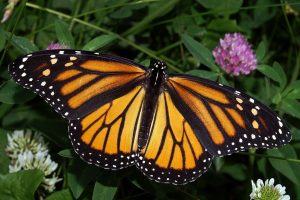
#1 Butterfly Bush – The name says it all: a butterfly bush attracts more Lepidoptera species of all types, including 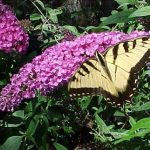 Monarchs. Know locally as the summer lilac, their tall spikes tubular flowers allow Monarchs to cling easily while drawing nectar from the many small tubular blooms. The long bloom season of this perennial shrub gives Monarchs a reliable supply of nourishment as they complete their long migration both north and south each year.
Monarchs. Know locally as the summer lilac, their tall spikes tubular flowers allow Monarchs to cling easily while drawing nectar from the many small tubular blooms. The long bloom season of this perennial shrub gives Monarchs a reliable supply of nourishment as they complete their long migration both north and south each year.
#2 Cosmos – is a member of the daisy family, cosmos are appealing to Monarch butterflies because of the bright flowers and precious nectar stores. Although a cosmos blossom looks like one flower, it’s actually made up of many different tiny tubular flowers surrounded by a ray of petals. Cosmos flowers are one of the easiest annuals to sow from seed. Broadcast the seed over your garden plot in early spring and Mother Nature will take care of the rest. This flower is extremely drought and heat tolerant, and thrive in the light frosts of early spring.
because of the bright flowers and precious nectar stores. Although a cosmos blossom looks like one flower, it’s actually made up of many different tiny tubular flowers surrounded by a ray of petals. Cosmos flowers are one of the easiest annuals to sow from seed. Broadcast the seed over your garden plot in early spring and Mother Nature will take care of the rest. This flower is extremely drought and heat tolerant, and thrive in the light frosts of early spring.
#3 Goldenrod – Don’t mistake goldenrod and ragweed. Ragweed is a notorious allergy 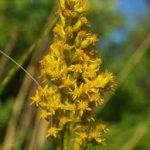 problem and blooms the same time in summer as goldenrod. There is a symbiotic relationship between goldenrod pollinators like butterflies and bees to carry off its heavy grains of pollen. Ragweed weed pollen light and airy and easily dispersed by the mountain winds. Goldenrod offers the garden a perennial firework of bright gold flowers all summer long.
problem and blooms the same time in summer as goldenrod. There is a symbiotic relationship between goldenrod pollinators like butterflies and bees to carry off its heavy grains of pollen. Ragweed weed pollen light and airy and easily dispersed by the mountain winds. Goldenrod offers the garden a perennial firework of bright gold flowers all summer long.
#4 Lantana – Even if your flower garden is limited to the smallest balcony, you can attract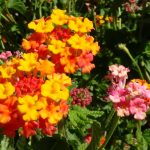 Monarchs with lantana. These plants are usually sold in full bloom, meaning you have an instant source of nectar to offer to foraging Monarchs. Grow lantana in full sun to prevent problems with powdery mildew. Lantana is best grown in hot sun and thrives in well-drained soil. Offered here at Watters in a host of summer colors. Miss Huff lantana is the only know mountain variety that comes back reliably each year.
Monarchs with lantana. These plants are usually sold in full bloom, meaning you have an instant source of nectar to offer to foraging Monarchs. Grow lantana in full sun to prevent problems with powdery mildew. Lantana is best grown in hot sun and thrives in well-drained soil. Offered here at Watters in a host of summer colors. Miss Huff lantana is the only know mountain variety that comes back reliably each year.
#5 Lilac – Your grandma’s favorite landscaping shrub belongs in your contemporary 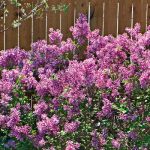 garden. Not only are today’s modern lilac mildew resistant than ever before, but newer cultivars like ‘Tiny Dancer’ are compact, and some like ‘Bloomerang’ offer a repeat bloom cycle to satisfy hungry butterflies. Every gardener should have at least one.
garden. Not only are today’s modern lilac mildew resistant than ever before, but newer cultivars like ‘Tiny Dancer’ are compact, and some like ‘Bloomerang’ offer a repeat bloom cycle to satisfy hungry butterflies. Every gardener should have at least one.
#6 Milkweed – Plants in the milkweed ‘Asclepias’ family are essential to adding the chemical to Monarch larvae that make them unpalatable to predators. In fact, this adaptation has been so successful for Monarchs that the Viceroy butterfly has evolved to mimic the color pattern of the Monarch, in hopes of evading predators. Watters sell our native mountain variety with a host of other colors so beautiful they can be added directly to container gardens and flower beds.
adaptation has been so successful for Monarchs that the Viceroy butterfly has evolved to mimic the color pattern of the Monarch, in hopes of evading predators. Watters sell our native mountain variety with a host of other colors so beautiful they can be added directly to container gardens and flower beds.
#7 Zinnia – Large butterflies like the Monarch enjoy wide-open spaces that allow them to 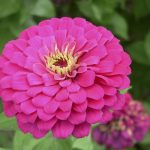 glide through the landscape unhampered. Zinnias are a frugal way to fill up large areas of the garden. One packet of zinnia seed for $2.29 yields the promise of a brightly colored nectar garden for Monarchs all summer long. You will also find hummingbirds are drawn to the same gardens.
glide through the landscape unhampered. Zinnias are a frugal way to fill up large areas of the garden. One packet of zinnia seed for $2.29 yields the promise of a brightly colored nectar garden for Monarchs all summer long. You will also find hummingbirds are drawn to the same gardens.
Garden classes have been posted to the website and start Saturday, July 8th with “Containers that Bloom like Crazy!”. If you have read this far, take special notice of the class on July 15 “Attract Birds, Bees & Butterflies”. Classes will be help at 9:30 am each Saturday through summer. Take a look at the entire class schedule here.
Until next week, I’ll be helping customer attract more butterflies here at Watters Garden Center.
Ken Lain can be found throughout the week at Watters Garden Center, 1815 W. Iron Springs Rd in Prescott, or contacted through his website at WattersGardenCenter.com or FB.com/WattersGardenCenter .

